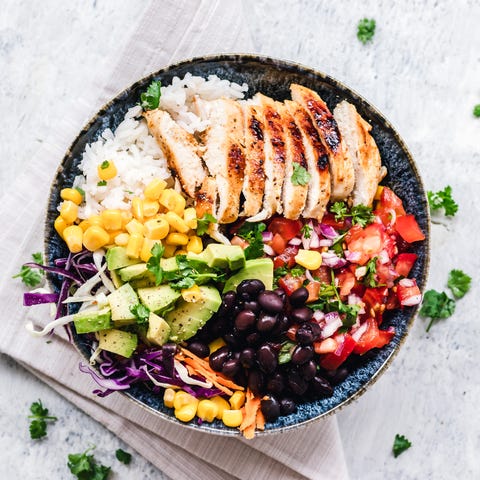what is not a way to classify muscles
Building muscle is why well-nigh of us constantly return to the gym. It'southward the buoy of light that continues to bulldoze our endeavour-driven workouts that many consider us crazy for, simply how do nosotros build muscle finer? That's the question that trips up so many lifters.
That'due south considering information technology's harder to build muscle than you might think. Building muscle isn't merely about going to the gym, and it'south non merely about eating pounds and pounds of poly peptide. To build musculus, you must push your muscles to the limit, then permit them recover and grow stronger as they exercise. And to practice this, you must create the proper recovery surround for them when you're not in the gym.
This means your quest to build musculus involves a host of variables over a 24-hour period. The things you lot do in the gym to push your muscles to the limit count. So does the "piece of work" you put in during the other xx or and so hours when you're abroad from the gym, everything from rest to nutrition to agile recovery. All of this can affect how y'all build muscle.
I of the best ways to become started is to understand and define what muscle-edifice actually is. Muscle hypertrophy is the increment in growth of muscle cells, and information technology's a process that's oft kickstarted by resistance preparation. Essentially, you lot need to push your muscles hard, ofttimes by lifting heavy loads for reps, stimulating the release of musculus-growing hormones and other metabolites.
Muscle hypertrophy is the adaptation our muscles experience from continual exposure to progressively overloaded forms of resistance training, which then results in an increment in our musculus cobweb size, both in diameter and length. Essentially, musculus hypertrophy is the process through which our muscles get physically larger through the act of strategically consistent and harder workouts.
Remember, effort is one of the nigh definitive drivers of muscle proceeds over time. Withal, information technology'southward simply ane of the drivers. That endeavour needs to be coupled with a desire to push your body farther than you might remember information technology's capable of. This is something called "progressive overload." If you lot're non familiar, progressive overload involves creating some grade of increased, strategic endeavour based on the style of preparation you're doing. This doesn't mean going heavier and heavier with the weights in every ready and every single workout, because sometimes, that's not possible. Over-focus on going heavy in every unmarried conditioning, and you gear up yourself up for injury and thwarting.
No, progressive overload takes identify over months and months of working out. Sure, if y'all're new to the gym, you may add major pounds to the bench press, partly because yous're but learning the do. Only the longer you're in the gym, the harder it is to make gains. This is why it's incredibly important to have a plan in identify and build a framework for your training and nutritional habits that coincide with your goals. "Workouts without a program only won't get y'all to the goals yous want," says MH fitness director Ebenezer Samuel, C.S.C.S. "You need a strategy."
Note, your muscle building strategy doesn't need to exist and then rigid that information technology leaves no room for fun. In fact, you can still swallow meals you enjoy, and you don't need to spend hours in the gym, as long equally when you're training and fueling yourself strategically a majority of the fourth dimension. The goal is to create a muscle edifice plan that is realistic for your goals and needs.
The tips beneath will assistance y'all—whether you lot're a beginner or somebody who'southward hit a frustrating training plateau—build muscle with a strategic and realistic ways.
This content is imported from {embed-name}. You lot may be able to observe the aforementioned content in another format, or you lot may be able to find more than data, at their web site.
The 10 Principles of Building Muscle
1. Maximize Muscle Building
The more poly peptide your trunk stores—in a procedure called poly peptide synthesis—the larger your muscles grow. Simply your body is constantly draining its protein reserves for other uses—making hormones, for instance.
The result is less poly peptide available for muscle building. To counteract that, you need to "build and store new proteins faster than your body breaks downward old proteins," says Michael Houston, Ph.D., a professor of nutrition at Virginia Tech University.
Shoot for about 1 gram of protein per pound of trunk weight, which is roughly the maximum amount your body can use in a twenty-four hours, according to a landmark study in the Journal of Applied Physiology.
For example, a 160-pound human should consume around 160 grams of protein a twenty-four hours—the amount he'd get from an 8-ounce chicken breast, one cup of cottage cheese, a roast-beef sandwich, two eggs, a glass of milk, and ii ounces of peanuts. Dissever the rest of your daily calories as between carbohydrates and fats.
2. Eat More
In addition to adequate protein, you need more calories. Use the post-obit formula to calculate the number yous demand to accept in daily to proceeds i pound a week. (Requite yourself 2 weeks for results to show up on the bathroom scale. If you haven't gained by then, increment your calories by 500 a day.)
- A. Your weight in pounds: _____
- B. Multiply A past 12 to go your bones calorie needs: _____
- C. Multiply B past ane.vi to estimate your resting metabolic rate (calorie burn without factoring in do): _____
- D. Strength training: Multiply the number of minutes you lift weights per week by 5: _____
- Due east. Aerobic grooming: Multiply the number of minutes per week that you run, wheel, and play sports by viii: _____
- F. Add together D and E, and divide past 7: _____
- G. Add C and F to get your daily calorie needs: _____
- H. Add 500 to K: _____. This is your estimated daily calorie needs to gain 1 pound a calendar week.
This content is imported from {embed-proper noun}. You may be able to notice the same content in some other format, or you lot may be able to find more data, at their web site.
3. Work Big, Not Small
Yes, biceps curls are fun, but if you want to put on musculus, you have to do more than to challenge your body. And one cardinal to doing that, says Samuel, is working through and so-called "multi-joint" movements. "Yes, isolation training has value," says Samuel, "but it can't exist the backbone of your preparation."
Instead, you want to exercise exercises that challenge multiple joints and muscles at once. Take, for example, a dumbbell row. Every row rep challenges biceps, lats, and abs. Using multiple muscle groups allows you to lift more weight, says Samuel, a key stimulator of growth (more on that subsequently). And information technology pushes yous to utilize muscles together, just as y'all do in real life. "Multi-joint moves are fundamental in your workouts," he says.
Brand sure moves similar squats, deadlifts, pullups, and bench presses are in your conditioning to have advantage of that. All will stimulate multiple musculus groups at the aforementioned fourth dimension, and in order to grow, you lot want to do that.
4. Train Heavy
If you desire to build muscle and strength, you accept to train heavy, says Curtis Shannon, C.S.C.S. "Preparation heavy, safely and efficiently, has many benefits," says Shannon. "Heavy training challenges the muscles non simply concentrically but eccentrically. If dont right, the stimulus of heavy weight going downward with control and going back up volition cause greater muscle tear and rebuild."
That means not every set up you do should have you pumping out 10-15 reps. Yes, high-rep sets can have value, but for multi-articulation moves like squats and bench presses, and deadlifts, don't be afraid to practice sets of, say, v reps. That'll allow you to use more weight, building more pure strength, says Samuel. And as you progress, that new strength will allow you to lift heavier weights for more than reps.
One way y'all can approach this in your training: Pb off every workout with an exercise that lets you train low-rep. Do 4 sets of 3-5 reps on your showtime exercise, and then do 3 sets of 10-12 reps for every motion afterwards that. "It's the best of both worlds," says Samuel, "letting you build pure strength early, then pile upward reps later."
5. Have a Drink Outset
A 2001 written report at the University of Texas found that lifters who drank a milk shake containing amino acids and carbohydrates before working out increased their protein synthesis more than than lifters who drank the same shake later exercising.
The shake contained 6 grams of essential amino acids—the musculus-building blocks of protein—and 35 grams of carbohydrates.
"Since exercise increases bloodflow to your working tissues, drinking a carbohydrate-protein mixture before your conditioning may lead to greater uptake of the amino acids in your muscles," says Kevin Tipton, Ph.D., an exercise and diet researcher at the Academy of Texas in Galveston.
For your shake, you'll demand near 10 to 20 grams of protein—usually virtually one scoop of a whey-protein powder. Tin't stomach protein drinks? You tin can get the aforementioned nutrients from a sandwich made with 4 ounces of cafeteria turkey and a slice of American cheese on whole wheat breadstuff. But a beverage is better.
"Liquid meals are absorbed faster," says Kalman. So tough it out. Drinkable 1 xxx to threescore minutes earlier your workout.
6. Don't Always Go Hard
Your body should movement every day, but that doesn't mean your workouts should take you lot to fatigue and exhaustion. "If y'all train your hardest every day, your torso doesn't go a chance to grow," says Samuel. "Pick your spots to assault." Aim to finish every workout feeling skilful, not dead. Limit your weight room workouts to 12-16 total sets of piece of work, and never go beyond that.
This doesn't hateful you tin't take on a fell conditioning every then oft. Only limit workouts that have your torso to its breaking point to 3 times a week, never on back-to-back days. "You need recovery to grow," says Samuel. "Constantly grooming to the point of burnout will be counterproductive to the recovery you need for muscle growth."
7. Down the Carbs Afterwards Your Conditioning
Research shows that you'll rebuild muscle faster on your rest days if you feed your body carbohydrates.
"Mail-conditioning meals with carbs increase your insulin levels," which, in plow, slows the charge per unit of poly peptide breakdown, says Kalman. Have a banana, a sports beverage, a peanut-butter sandwich.
8. Challenge Yourself with Progressive Overload
Equally we mentioned before, one major key to muscle-building is pushing your muscles to handle progressively greater challenges. In general, most gym-goers think that means yous must lift heavier in every single workout. That'south just not the case, says Samuel. "At that place comes a point where it becomes harder to simply put more than weight on the bar," he says. "If that wasn't the case, everyone would be benching 300 pounds."
Don't only aim to add weight on every set of every exercise, says Samuel. But practise piece of work to better in some fashion on every gear up of an exercise. "Even if you're non going up in weight, y'all tin can push button yourself in different ways," he says. "You lot might exercise 10 reps of deadlifts this set. On the next set, instead of adding weight, do the aforementioned 10 reps, but do them with fifty-fifty sharper grade."
Sometimes, staying with the aforementioned weight for all four sets on a day can provide plenty of claiming, says Samuel, especially when you're improving your execution every fix. At that place are other forms of progressive overload too. Y'all tin subtract the balance time between sets, going from, say, 120 seconds to xc seconds, or y'all tin up the reps, or you tin can fifty-fifty do more sets.
"Aim to improve every conditioning," says Samuel, "only know that that improvement won't always look the aforementioned. I may deadlift 315 pounds today 4 times and not exist able to add together weight. But if I can squeeze out a 5th rep, or even do my 4 reps with more control than I did last week, I'yard on the right runway."
9. Maximize Time Under Tension
One sometimes-forgotten fashion to progressively overload your muscles is to go out them under more of something called "time under tension". When you're muscles are working, whether they're under a demote press bar, or whether your biceps is working to curl a dumbbell upwards, they're under "tension" from the weight. You can experience this too: If yous stand up holding dumbbells at your sides, your biceps aren't under tension. The moment y'all begin to curl them up, yous'll feel them flex confronting the "tension" of the dumbbells.
Experienced lifters often apply this tension to their advantage. Instead of just lifting and lowering a weight (on say, that biceps curl), they lift with a specific tempo. They might curl upwards equally fast as they tin, for example, and so lower the weight for three focused seconds with good course on every rep.
Doing this leaves your muscles under tension for longer than a typical set, in which yous might lift and lower the weight without any specific timing. And that extra time under tension during a set can help spark muscle growth.
Notation that you lot tin can practise this on almost whatsoever strength practise. It doesn't work for explosive exercises, like kettlebell swings, snatches, and cleans. But squats, deadlifts, curls, pullups and pushups (and many other moves) can exist tweaked to add together more time-under-tension, pushing your muscles further on every rep.
x. Sleep At Least 6 Hours
Sleep is frequently the forgotten variable in the journeying to musculus. You spend plenty of time training, simply what you ofttimes don't realize is this: When you're asleep, your muscles are recovering and your body is growing. It's besides during this catamenia that muscle-growing hormones are secreted.
You know by at present that, ideally, you want to get eight to x hours of sleep. That, of course, doesn't always happen, only y'all want to practise what you tin to maximize the quality of the hours you practice get, if yous tin can't hit 8 hours.
So recollect about your sleep setup if you're serious about muscle. Effort to get to bed at the aforementioned time every day and endeavour to rise at the aforementioned time every solar day. And slumber in a fully dark, fully quiet absurd room. All these fiddling things optimize slumber quality and that tin accept an underrated issue on your ability to build musculus.
The Whey To Go for Muscle Growth
Beverage this poly peptide ability shake before every workout.
Weight-gain powders seem like an like shooting fish in a barrel solution to a skinny guy'southward problems. After all, they pack as many as 2,200 calories into ane serving. Merely yous're not getting what you pay for.
"Loftier-calorie weight-gain drinks normally get more than fourscore percent of their calories from sugar," says Doug Kalman, R.D. And downing that much carbohydrate can requite you an upset breadbasket and diarrhea.
Then, in a sense, you're flushing skillful money down the toilet. "Y'all'll go much better results by spreading your calories throughout the day," says Kalman.
And past using protein shakes. Look for whey protein powders at diet stores. Combine 1 scoop of the pulverisation with the following ingredients and blend for a homemade muscle-building pre-workout milkshake:
- i tsp olive or flaxseed oil
- 1/2 c fat-free yogurt
- 1 c grape or apple tree juice
Stats per shake: 335 calories, 27 gram poly peptide, 45 grams carbohydrates, half-dozen grams fatty
Desire more than poly peptide-packed muscle-edifice goodness? Check out these healthy milk shake recipes.
This content is created and maintained past a third party, and imported onto this folio to help users provide their email addresses. You may exist able to discover more information about this and like content at piano.io
Source: https://www.menshealth.com/fitness/a19534499/10-muscle-building-tips/







0 Response to "what is not a way to classify muscles"
Post a Comment